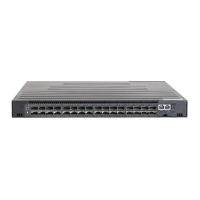C
HAPTER
23
| Authentication Commands
802.1X Port Authentication
– 853 –
COMMAND USAGE
This command displays the following information:
◆ Global 802.1X Parameters – Shows whether or not 802.1X port
authentication is globally enabled on the switch (page 842).
◆ Authenticator Parameters – Shows whether or not EAPOL pass-through
is enabled (page 842).
◆ Supplicant Parameters – Shows the supplicant user name used when
the switch responds to an MD5 challenge from an authenticator
(page 849).
◆ 802.1X Port Summary – Displays the port access control parameters
for each interface that has enabled 802.1X, including the following
items:
■
Type – Administrative state for port access control (Enabled,
Authenticator, or Supplicant).
■
Operation Mode – Allows single or multiple hosts (page 844).
■
Control Mode – Dot1x port control mode (page 845).
■
Authorized – Authorization status (yes or n/a - not authorized).
◆ 802.1X Port Details – Displays the port access control parameters for
each interface, including the following items:
■
Reauthentication – Periodic re-authentication (page 846).
■
Reauth Period – Time after which a connected client must be re-
authenticated (page 847).
■
Quiet Period – Time a port waits after Max Request Count is
exceeded before attempting to acquire a new client (page 846).
■
TX Period – Time a port waits during authentication session before
re-transmitting EAP packet (page 848).
■
Supplicant Timeout – Supplicant timeout.
■
Server Timeout – Server timeout. A RADIUS server must be set
before the correct operational value of 10 seconds will be displayed
in this field.
■
Reauth Max Retries – Maximum number of reauthentication
attempts.
■
Max Request – Maximum number of times a port will retransmit an
EAP request/identity packet to the client before it times out the
authentication session (page 844).
■
Operation Mode– Shows if single or multiple hosts (clients) can
connect to an 802.1X-authorized port.
■
Port Control–Shows the dot1x mode on a port as auto, force-
authorized, or force-unauthorized (page 845).
■
Intrusion Action– Shows the port response to intrusion when
authentication fails (page 843).
■
Supplicant– MAC address of authorized client.

